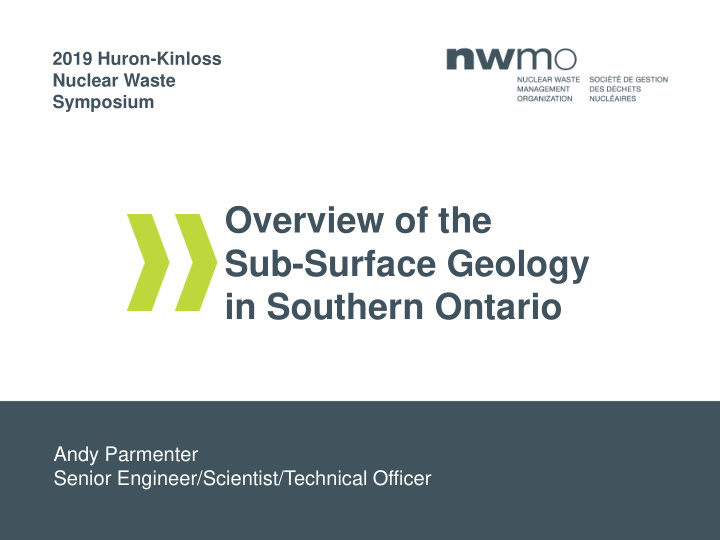



2019 Huron-Kinloss Nuclear Waste Symposium Overview of the Sub-Surface Geology in Southern Ontario Andy Parmenter Senior Engineer/Scientist/Technical Officer
Geological Features of Southern Ontario Contours represent thickness of the sedimentary sequence in metres 2
3
Regional Surface Bedrock Geology 4
Regional Geological Cross-section - Eastern Section of Michigan Basin Section is about 150 km long with a 45x vertical exaggeration 5
OGSRL Wells and Cross Sections OGSRL: Ontario’s Oil, Gas and Salt Resources Library 6
Cross Sections N-S and E-W 7
Characterization of the bedrock geology at the Bruce nuclear site 8
Hydraulic Testing at the Bruce Nuclear Site Hydrogeological studies seek to understand groundwater migration and mass transport through the subsurface 9
Rock Strength Testing from Bruce Nuclear Site Laboratory tests reveal the high strength of the Cobourg argillaceous limestone 10
Groundwater and Porewater at the Bruce Nuclear Site Consistent with Regional Hydrogeochemistry for S. Ontario (NWMO-DGR-TR-2011-12) A shallow system (<200 mBGS) with fresh through brackish waters. Waters in this system have stable isotopic compositions consistent with mixing of dilute, recent or cold-climate (glacial) waters with more saline waters. An intermediate to deep system (>200 mBGS) containing brines with elevated TDS values (200-400 g/L). The stable isotopic compositions of these waters are typical of sedimentary basin brines. TDS = Total Dissolved Solids 11
Groundwater and Porewater at the Bruce Nuclear Site (cont’d) Groundwater Age Estimates The ages of shallow Devonian and Upper Silurian groundwater have been investigated by 14C dating. Although uncertainties exist, the ages range between about 4000 and 8000 years BP, suggesting the groundwater is relatively old Holocene groundwater. Based on isotope analyses ( 129 I, He) from porewaters in Ordovician shales and the Cobourg Formation, groundwater ages are greater than 80 million years. Adapted from NWMO, 2011. Descriptive Geosphere Site Model, NWMO DGR-TR-2011-24. TDS = Total Dissolved Solids 12
Potentially Suitable Host Rock Formation • Data from the OGSRL well database indicates that the bedrock geology beneath this part of southern Ontario consists of a laterally extensive and predictable Paleozoic sequence. • The initial screening reports (2012) identified the Upper Ordovician shale and limestone units as potentially suitable host rock formations. • Based on available geoscientific information, the Ordovician Cobourg Formation (argillaceous limestone) would be the preferred host rock as it has sufficient thickness and volume and favourable characteristics of very low hydraulic conductivity and high geomechanical strength. • The approximately 200 m thickness of Upper Ordovician shale formations overlying the Cobourg Formation, would act as an additional hydraulic barrier. 13
Questions? 14
Recommend
More recommend